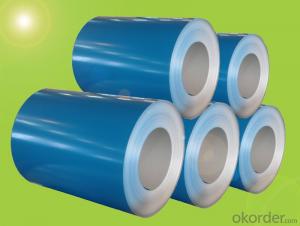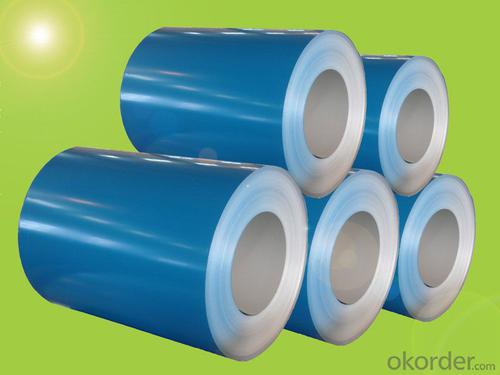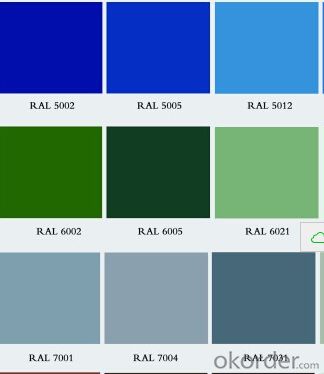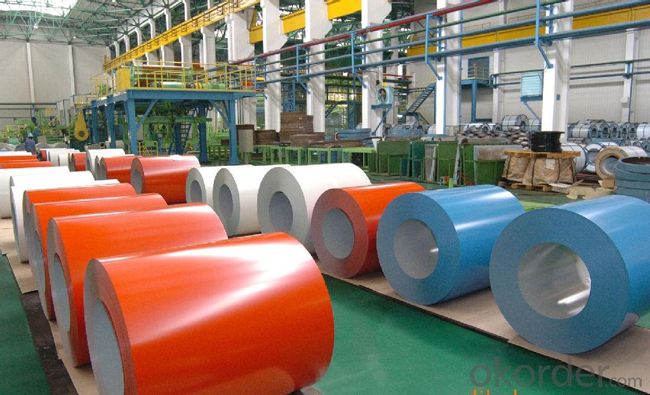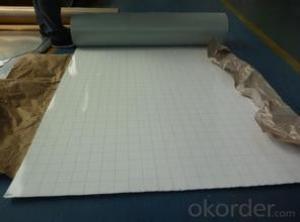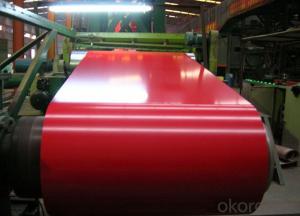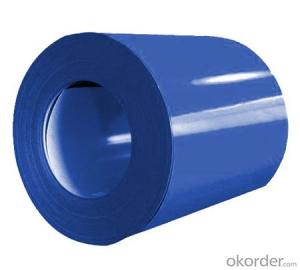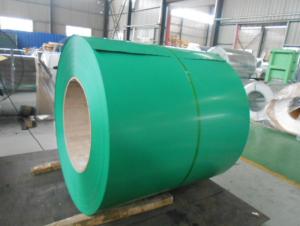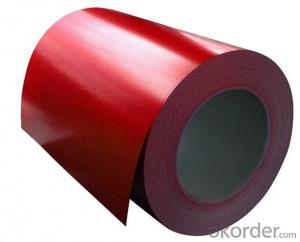Hot Sale Painted Steel Coil
- Loading Port:
- China Main Port
- Payment Terms:
- TT OR LC
- Min Order Qty:
- -
- Supply Capability:
- -
OKorder Service Pledge
OKorder Financial Service
You Might Also Like
Product Features
super weather resistance and durability , also the pattern is capable to bring about plenty of effects of multilayer, parallax and 3D effect.
Application
It is the perfect building material in construction for making steel roofing/suspended ceiling, office partition, Sandwich panel, insulation panel, corrugate sheet, facade wall,rolling doors, T-bar, garage door and shutters etc.
Structure of Cross-section
Items | Thickness | Type | Features |
Protection Film | 50μm | polyethylene | Protecting from scratches and |
Finished Coat | 10μm | PVDF | Protecting printed layer and enhances |
Print | ≦1μm | Ink, Polyester | Various printing patterns,3 colors overprint |
Top Coat | 20μm | Polyester Fluorine | Chemical resistance, formability and |
Primer Coat | 5μm | Polyester | workability, corrosion resistance and |
Chemical Treatment | ≦1μm | Chromate | Good adhesion and corrosion resistance |
Substrate | 0.2-1.2mm | GI.GL.AL | GI.GL,AL |
Chemical Treatment | ≦1μm | Chromate | Good adhesion and corrosion resistance |
Back Coat | 5μm | Epoxy | corrosion resistance and adhesion to the |
- Q: At what temperature does steel start to warp or soften.
- Steel will only warp due to temperature under two conditions: 1. It is not heated evenly - in this case, the hotter parts will expand more than the cooler parts. 2. There are internal stresses in the steel (often from welding or cold-working - as an example, an I-beam or C-channel is usually hot worked, but some cold work can happen, so they can sometimes warp if you heat them ). This means that the steel won't warp due to temp if it's not 1 or 2. However, it could soften and fail if it has a load on it. As for softening, it really depends on what steel alloy you're looking at. Some steels (mainly the expensive alloys) don't really change until above 400 C (750 F), but mild steel really starts to weaken around 150-200 C (300-400 F) Rajashekhar has a point when it comes to forging. Steel isn't really soft enough to forge properly until above 1000C (1830 F), but if you're worried about using steel in a higher temp situation (like around a blast furnace or industrial oven), then make sure you choose a steel that has been rated to work at that temp.
- Q: What are the common certifications required for steel coils?
- The certifications needed for steel coils differ based on the industry and purpose of the coils. However, there are various certifications that are commonly requested. 1. ISO 9001: This certification ensures that the manufacturer has established a quality management system that meets global standards. It confirms that the manufacturer has the necessary procedures and controls in place to consistently produce high-quality steel coils. 2. ISO 14001: This certification concentrates on environmental management systems. It guarantees that the manufacturer is dedicated to minimizing its environmental impact and reducing waste during the production process. 3. ISO 45001: This certification relates to occupational health and safety management systems. It ensures that the manufacturer has implemented measures to safeguard the health and safety of its employees and stakeholders. 4. ASTM International Standards: The American Society for Testing and Materials (ASTM) has introduced various standards for steel coils. These standards include chemical composition, mechanical properties, and dimensional tolerances. Adhering to these standards guarantees that the coils meet the specified requirements and are suitable for their intended use. 5. EN Standards: The European Committee for Standardization (CEN) has developed a series of standards for steel coils, known as EN standards. These standards cover similar aspects as ASTM standards but are specific to the European market. 6. JIS Standards: The Japanese Industrial Standards (JIS) are widely used in the steel industry in Japan and other Asian countries. Complying with JIS standards ensures that the coils meet the specific requirements of the Japanese market. 7. Certifications specific to products: Depending on the application of the steel coils, additional certifications may be necessary. For instance, if the coils are intended for automotive use, certifications like ISO/TS 16949 (Quality Management Systems for the Automotive Industry) may be required. It is crucial to note that the specific certifications needed may differ based on the region, industry, and customer requirements. Manufacturers should consult their customers and industry standards organizations to determine the exact certifications necessary for their steel coils.
- Q: I just got the game Red Steel for the Wii. I want to use the sword in multiplayer mode, but I can't find it. Is it only for single player?
- Sure.
- Q: How are steel coils inspected for chemical composition using spectroscopy?
- Spectroscopy techniques such as X-ray fluorescence (XRF) and laser-induced breakdown spectroscopy (LIBS) can be employed to examine the chemical makeup of steel coils. XRF involves directing an X-ray beam onto the surface of the steel coil, prompting the sample's atoms to emit distinct X-ray fluorescence radiation. By examining the energy and intensity of these emitted X-rays, one can determine the elemental composition of the steel. This method is both rapid and non-destructive, enabling swift and accurate assessment of the steel coil's chemical composition. On the other hand, LIBS entails focusing a laser beam onto the steel coil's surface, generating a high-temperature plasma. The plasma emits light, which is subsequently collected and analyzed using a spectrometer. This emitted light contains characteristic atomic and ionic emissions, allowing for the identification and quantification of various elements present in the steel. LIBS is also a non-destructive technique, providing real-time results and requiring minimal sample preparation. Both XRF and LIBS offer multiple benefits in terms of speed, non-destructiveness, and user-friendliness for inspecting the chemical composition of steel coils. These spectroscopic techniques play a vital role in quality control and assurance, ensuring that the steel meets the necessary specifications and standards for diverse industrial applications.
- Q: given the buoyant economic growth of india, what you guys think about steel industry? what can be the major issues in this industry in the coming days
- Since2003, India has been the largest sponge iron producer in the world. In 2005, out of total global production of 56.05 mt of sponge iron, India produced around 11.1 mt (19.8%). In line with production target of 110 mt of steel (National Steel Policy) by FY20, many steel producers have announced their capacity expansion plans by signing MOUs with various state governments like Chattisgarh, Orissa and Jharkhand. The steel producers are expected to add around 8 mt of capacity by FY 08. CARE estimates that during 2006-09, demand for steel in the domestic market would grow at a CAGR of 8.4%. HR steel because of its widespread applicability is expected to grow at a CAGR of 17.5%. During this period, major demand drivers would be Consumer durables, Automobiles and Construction. Domestically, steel prices of flat products follow the international trend. Globally, steel prices are expected to firm up with continued growth in steel consumption. Further, the winds of consolidation have gathered pace with Arcelor-Mittal merger and latest acquisition of Corus by Tata Steel. The Indian steel industry has announced huge capacity expansions. With commissioning of these capacities demand-capacity ratio is expected to decline in FY 09 due to excess capacity. Will this lead to a drop in prices with commissioning of these capacities? With China and India becoming the focus of major global steel companies, will the consolidation of steel industry in these countries continue? For comprehensive analysis and CARE’s future outlook on the sector, please refer to the exhaustive report on the Indian Steel Industry by CARE Research.
- Q: How are steel coils coated for color and aesthetics?
- Steel coils can be coated for color and aesthetics through a process called coil coating. This process involves applying a layer of paint or coating material to the surface of the steel coil to enhance its appearance and provide protection against corrosion. The coil coating process typically begins with a thorough cleaning and pre-treatment of the steel surface. This step ensures that the surface is free from any contaminants and provides a suitable base for the coating to adhere to. The pre-treatment process may involve cleaning, degreasing, and chemical treatment to enhance the adhesion and durability of the coating. Once the surface is prepped, the coil is then fed through a continuous coating line. In this line, the coating material, which is usually a liquid paint, is applied to both sides of the steel coil using various methods such as roll coating, spray coating, or electrostatic coating. The coating material is carefully selected to provide the desired color, texture, and durability. After the coating is applied, the coil goes through a curing process, where it is heated to allow the coating material to dry and bond to the steel surface. This ensures a strong and durable finish that can withstand exposure to various environmental conditions. Coil coating technology also allows for additional treatments to enhance the aesthetics of the steel coil. For example, the coil can undergo a process called embossing, where a pattern is embossed onto the surface, giving it a textured or three-dimensional appearance. Additionally, other decorative techniques like printing, laminating, or adding metallic effects can be employed to achieve specific aesthetic effects. Overall, the coil coating process not only adds color and aesthetics to steel coils but also provides a protective layer that increases their lifespan and resistance to corrosion. This makes them suitable for a wide range of applications, including roofing, automotive parts, appliances, and construction materials.
- Q: What are the different surface finishes of steel coils?
- There are several different surface finishes of steel coils, including mill finish, galvanized finish, painted finish, and coated finish.
- Q: The length of a steel beam increases by 0.78 mm when its temperature is raised from 22 degrees C to 35 degrees C. What is the length of the beam at 22 degrees C (in meters)?I used: L = (0.78 mm)/[(9/5)(.00000645 F)(13)] = 5.17 meters but Mastering Physics said Not quite. Check through your calculations; you may have made a rounding error or used the wrong number of significant figures. I'm confused because this is how we learned this kind of problem in class, so if anybody knows what I did wrong, feel free to correct my errors! Thanks
- the welded joints,...are then sturdy steel, and conducts warmth very very right this moment, so develop from warmth often is the comparable because of fact the plate steel around it. you may desire to slope the backside and have a condensate seize gadget, steam secure practices stress alleviation valve, sized for the quantity and pressures, totally lag the vessel, adhere to ALL secure practices specs., (of your codes), which comprise the welding NDT. in the tank layout enable for the thermal develop of the vessel. cheers.
- Q: My uncle got me some new 'Nam style jungle boots at the px at Fort Worth JSB, and he told me that back in Vietnam, they used to issue guys steel sole boots, that had a sole reinforced with a steel plate, as punji stick d-fence. Is this true, it sounds logical, but I can't figure out how a steel plate in the sole would work. My uncle is kind of a BS'er, plus he wasn't even in Vietnam, much less the Infantry, much less combat, but he was in USAF at the time.
- The issue of steel soled boots in Vietnam did actually happen. The steel plate is in the mid-sole, to prevent punji sticks (or other sharp objects) from penetrating the boot if you stepped down on them. These bamboo or metal spikes - often coated with human excrement - were placed in shallow (camouflaged) pits dug in the ground or sometimes under water at places where you'd ford a stream. Quite apart from the physical injury from stepping on one, there was a high risk of serious infection from what they were coated with. Originally the steel plate was issued as an insole to go inside but that give the soldiers blisters, so later the boots were manufactured with it as part of the sole. Steel toe-cap boots containing a mid-sole plate are sold today for use by builders and construction workers who have a similar risk of stepping on nails, screws, glass, etc.
- Q: nylon sounds alot better but i want to keep the acoustic i have now. Is it proper to put nylon on an acoustic guitar meant for steel strings?
- Nylon Strings For Acoustic Guitar
Send your message to us
Hot Sale Painted Steel Coil
- Loading Port:
- China Main Port
- Payment Terms:
- TT OR LC
- Min Order Qty:
- -
- Supply Capability:
- -
OKorder Service Pledge
OKorder Financial Service
Similar products
Hot products
Hot Searches
Related keywords
